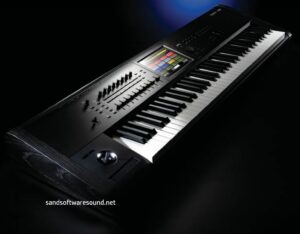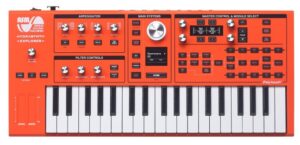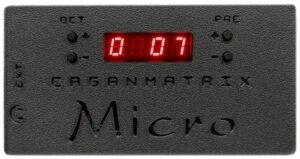LD Systems ANNY powered speakers
LD Systems will feature the ANNY Series of portable battery powered PA systems. There are two models: a small 8″+1″ carry-about (8.8kg) with tilt-back and a larger 10″+1″ roll-about (18kg) model. Buskers should check these out.
Both models have well-featured mix and effect capabilities. The ANNY 8 is $550 in black. You get to choose your color for a small up-charge.
Headrush FRFR GO
Yeah, the Headrush FRFR GO is intended for guitar and bass. “FRFR” means full range flat response, and keyboardists should give FRFR products a test when looking for amplification. Headrush, BTW, are part of the InMusic product conglomerate and the Headrush amps have more than a passing resemblance to models by Alesis and Alto.
The FRFR Go is 30 Watts (24 Watts on battery) into two 3-inch speakers with rear bass port. No, you won’t shake the walls. However, you will save your back:
- 12.6″ x 7.2″ x 5.9″ (32 x 15 x 18.4 cm)
- 7.4 pounds (3.35kg)
The 1/4 inch input is LINE level because the FRFR GO expects to be driven by a direct amp modeler. Why not a line-level synth? There is a 3.5mm AUX input, too.
Controls are simple: INPUT volume, bass, treble and MAIN volume. The bass and treble allow adjustments for the room/venue. Frequency response is 75Hz to 20kHz (-10dB) and maximum SPL is 109.4dB.
The one big unanswered wish is an XLR output. Oh, to be able to use the FRFR GO as a personal monitor tied into a PA! Alto, are you listening?
Oh, yeah, $149 USD. 🙂
On-Stage, again
Still more from On-Stage.
The On-Stage OS TGA01 is a rechargeable (via USB-C) travel amp with up to seven hours playing time. It’s 4 inches tall and weighs 0.65 pounds. The TGA01 is not much bigger than tiny plug-in headphone amps.
The TGA01 drives 5 Watts into two 1.75″ full-range speakers. A button selects overdrive (OD) or clean. There are three knobs: gain, tone and volume. This baby clearly targets guitar. The TGA01 has a headphone OUT and Bluetooth IN.
The KS1355 is a new single-tier keyboard Z stand:
- Height adjustment: 20.5″ to 33.5″
- Width adjustment: 21″ to 34″
I like the smaller width as it’s difficult to find an X stand that works with mini keyboards. Weight capacity is 400 pounds — over-kill for a mini keyboard!
No prices for the TGA01 or KS1355 at this time.
Whither new keyboards?
In a major announcement, Nord have introduced the two manual Nord Organ 3. Here’s the new stuff:
- Enhanced B3 organ model with improved chorus/vibrato
- Improved Farfisa and Vox organ models
- Bass synth options (think “pedals”)
- Rotary speaker emulation
- British amp speaker emulation
- Spring reverb
- New modulation effects
- Triple sensor keybeds
- New front panel with OLED display
A two manual organ (37.5 pounds, 17kg) is waaaaaaay too much for me to haul around and the Nord Organ 3 will land around $3,250 USD. Still, I’m glad to see Nord innovating and leading. This will force the competition to meet the challenge and maybe I’ll get a single manual organ at a reasonable weight and price — someday.
Flash! Korg will be announcing a new updated KRONOS.
So, where are the other new keyboards? I’m not seeing any interesting keyboard rumors for NAMM 2025. I expect the daikaiju to feature their most recent releases:
- Yamaha
- SEQTRAK music production studio
- PSR-SX720 and PSR-SX920 arranger workstations
- CLP-800 series Clavinova digital pianos
- EZ-310 portable keyboard
- Korg
- New KRONOS
- Grandstage X stage piano
- microKORG2 synthesize/vocoder
- multi/poly analog modeling synthesizer
- nanoKEY Fold foldable MIDI keyboard
- PianoRec digital piano recorder for smart phone
- Roland
- Earth Piano software instrument
- JUNO-D6, D7, D8 synthesizer
- Bridge CAST ONE dual-bus streaming mixer
- BOSS KATANA-MINI X, GX-10, SDE-3, etc.
- Casio
- AP-300 Celviano digital piano
- AP-S200 Celviano slim profile digital piano
Yamaha are teasing new announcements to be made on January 23: winds, drums and percussion, and PRO audio. I think they will be focusing on the TransAcoustic (TAG3 C 2nd generation) guitars and the gee-whiz TA technology within. TAG3 C TransAcoustic guitars ($1,700 USD) have built-in looper, reverb, chorus and Bluetooth.
If I need to go out on a limb, I predict an upgraded Stage YC Mark 2 (YC61 mk2, YC73 mk2, YC88 mk2). I stand by my blog suggesting a unified (organ+piano) professional stage keyboard line, that is, the PRO-level niche above the CKs.
Kawai will show the ES60 entry-level slab piano. Kawai are teasing two new “groundbreaking” products.
You won’t have any trouble spotting the orange ASM Hydrasynth Explorer 888 models. The 888s are a compact 37-key Hydrasynth with a mid-sized polyphonic keybed. We’ll find out what “mid-sized” means. The 888 Units edition is $650 USD.
Odisei Music are rolling out the electronic Travel Clarinet. The Travel Clarinet joins the successful Kickstarter Travel Sax. It has 50 internal sound presets, USB-C connectivity, battery power, and an internal reference speaker.
The Kiviak Instruments WoFI Portable Sampler Keyboard with WiFi ($800) is now shipping and is in stock.
Copyright © 2025 Paul J. Drongowski
























